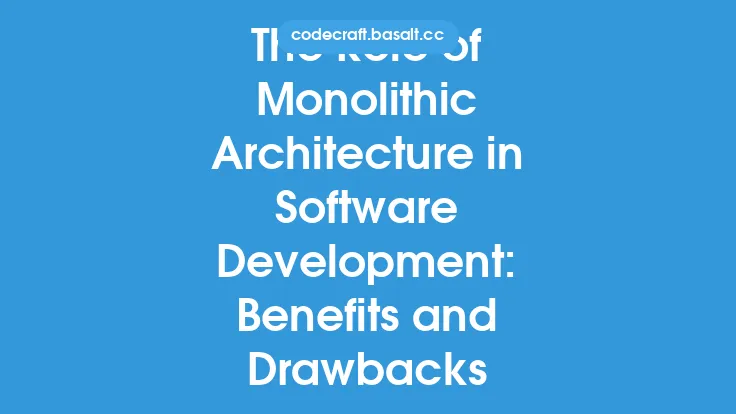In software development, the choice of architecture is a critical decision that can significantly impact the success of a project. One of the most traditional and widely used architectures is the monolithic architecture. This approach involves building a self-contained application with a single, unified codebase, where all components and features are interconnected and interdependent. While monolithic architecture has been the cornerstone of software development for decades, it has its pros and cons, which are essential to understand for developers, architects, and project managers.
Introduction to Monolithic Architecture
Monolithic architecture is characterized by a single, monolithic codebase that contains all the application's logic, data, and functionality. This means that the entire application is built as a single unit, with all components and features tightly coupled and interdependent. The monolithic approach is often contrasted with modular or microservices architecture, where the application is broken down into smaller, independent components that communicate with each other through APIs or other interfaces. Monolithic architecture is often preferred for small to medium-sized applications, where the complexity of the system is relatively low, and the development team is small.
Advantages of Monolithic Architecture
One of the primary advantages of monolithic architecture is its simplicity. With a single codebase, developers can focus on writing code without worrying about the complexity of integrating multiple components or services. This approach also makes it easier to develop, test, and deploy the application, as all changes are made to a single codebase. Additionally, monolithic architecture can be more efficient in terms of resource utilization, as all components share the same memory space and resources. This can result in better performance and faster execution times. Furthermore, monolithic architecture is often more secure, as there are fewer attack surfaces and vulnerabilities, compared to modular or microservices architecture, where multiple components and interfaces can increase the risk of security breaches.
Disadvantages of Monolithic Architecture
Despite its advantages, monolithic architecture has several disadvantages. One of the primary concerns is scalability. As the application grows in size and complexity, the monolithic codebase can become unwieldy and difficult to maintain. This can lead to longer development cycles, increased bugs, and reduced productivity. Additionally, monolithic architecture can make it challenging to adopt new technologies or frameworks, as the entire codebase may need to be rewritten or refactored. Another significant disadvantage is the lack of flexibility. With a monolithic architecture, it can be difficult to make changes to individual components or features without affecting the entire application. This can lead to a rigid and inflexible system that is resistant to change. Furthermore, monolithic architecture can make it challenging to achieve high availability and fault tolerance, as a single point of failure can bring down the entire application.
Technical Challenges of Monolithic Architecture
From a technical perspective, monolithic architecture can pose several challenges. One of the primary concerns is the risk of tight coupling, where components and features are heavily dependent on each other. This can make it difficult to modify or replace individual components without affecting the entire system. Another challenge is the lack of separation of concerns, where different components and features are mixed together in a single codebase. This can lead to a complex and convoluted system that is difficult to understand and maintain. Additionally, monolithic architecture can make it challenging to implement continuous integration and continuous deployment (CI/CD) pipelines, as the entire codebase needs to be built, tested, and deployed as a single unit.
Best Practices for Implementing Monolithic Architecture
While monolithic architecture has its disadvantages, there are several best practices that can help mitigate these challenges. One of the primary best practices is to keep the codebase organized and modular, with clear separation of concerns and loose coupling between components. This can be achieved through the use of design patterns, such as the Model-View-Controller (MVC) pattern, and architectural principles, such as separation of concerns and single responsibility principle. Another best practice is to use automated testing and CI/CD pipelines to ensure that the application is thoroughly tested and validated before deployment. Additionally, it is essential to have a robust monitoring and logging system in place to detect and respond to issues quickly.
Conclusion
In conclusion, monolithic architecture is a traditional and widely used approach to software development that has its pros and cons. While it offers simplicity, efficiency, and security, it can also be inflexible, difficult to scale, and challenging to maintain. By understanding the advantages and disadvantages of monolithic architecture, developers, architects, and project managers can make informed decisions about when to use this approach and how to mitigate its challenges. By following best practices, such as keeping the codebase organized and modular, using automated testing and CI/CD pipelines, and implementing robust monitoring and logging, it is possible to build successful and maintainable monolithic applications that meet the needs of users and stakeholders.





